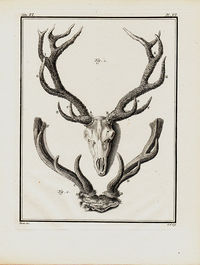Annotation:Cabar Féidh
Back to Cabar Féidh
CABER FÉIDH (Deer's Antlers). AKA - "Caber/Caper Fey/Fei/Feigh," "Caberfei]]," "Caberfea." AKA and see: "Cameronian('s) Rant (The)," "Copperplate (1) (The)," "Deer's Horns," "Jack Smith's Favorite," "Rakish Paddy." Scottish, Canadian, Shetland; March, Reel and Country Dance. Canada, Cape Breton. C Major (most versions): D Major (Jean Carignan, Martin/2002, O'Farrell). Standard tuning (fiddle). AB (most versions): AABB (Begin, Martin, O'Farrell). A particularly popular reel that has long been a mainstay of Scottish tradition and has been subsumed into the Irish. The earliest record of the tune is in Scottish musician David Young's MS. of 1734, called the Drummond Castle MS (because it was in the possession of the Earl of Ancaster at Drummond Castle) or The Duke of Perth MS. It is entered as "Caper Fei" and is a set with variations. The MS is inscribed 'A Collection of the best Highland Reels written by David Young, W.M. & Accomptant." The melody also appears in Young's Bodlein MS (1740, named for the Bodlein Library, Oxford, where it is kept), the McLean Collection (published by James Johnson in Edinburgh in 1772), and in the McFarlane MS of 1740 (where it is credited to David Young). In Robert Bremner's 2nd Collection (1768) it is printed in four parts in the key of C (with both f sharp and f natural accidentals). Cooke prints the following words to the tune, collected in the Shetland islands:
Mary made away being good luck wi' Teddie
All grown doss (toss?) makin me a dock an piddie.

The piece is often played in Scotland as a medley with "Bob of Fettercairn (The)," and is the tune for the famous Highland Dance called the "Caber Feidh," in which the dancers symbolically simulate the shape of deer's antlers with arms and fingers. From time immemorial a march version has been the clan march, rallying call, and insignia of the MacKenzie clan, "and in the eighteenth and nineteenth centuries it was the official march used to signal the charge of Highland troops" (Cowdery). Pipers generally consider the strathspey, reel and even jig versions of the tune to be relatively recent adaptations; in point of fact, the strathspey version is by Pipe Major W. Ross (a member of the Scots Guards from 1896 to 1918) while the jig is by a modern musician, D. Johnstone. Cape Breton fiddler and editor Paul Stwart Cranford (1995), however, suspects that Bremner's 1768 variations may have been a strathspey setting due to his particular grouping of sixteeth notes. Jean Carignan, taxi driver and famous Canadian fiddler from Montreal Canada, played the tune in the relatively rare (for this tune) key of D Major.
With adaptations made necessary (according to Paul Stewart Cranford) by the scale available to 19th century Irish pipes, the tune also entered into Irish tradition. Despite its Scottish origins, it is a member of the tune family Cowdery (1990) classifies under the Irish reel "Rakish Paddy." See also "Rakish Paddy," "Padraig Reice," "Glastertown's Downfall," "Castle Street Reel (The)," "Copperplate (1) (The)," "Sporting Pat (1)," "Cameronian Rant." O'Neill (1922) remarks: "When first received with a batch of fine tunes noted down by our unselfish friend Francis E. Walsh from the playing of clever San Francisco musicians, the foregoing reel under a slightly different name was recognized as a variant of 'Rakish Paddy' previously printed in The Music of Ireland, and O'Neill's Dance Music of Ireland. Another variant named 'Sporting Pat' is to be found in O'Neill's Irish Music for Piano or Violin. Under the circumstances, another variant seemed superfluous, but coming from such a famous fiddler as John Kelly of Roscommon, it has been cheerfully welcomed to our pages. A favorite with all capable pipers and fiddlers of our acquaintance for many years, the tune under any of its recognized names does not appear in the Bunting, Petrie or Joyce publications. As 'Caper Fey' it was printed in Bremner's Second Collection of Scots Reels or Country Dances, London 1768; yet omitted from The Glen Collection of Scottish Dance Music, Edinburgh 1891. Most Highland Bagpipe note books include a suitable setting of the tune under the correct title as above, in Gaelic and English."
As "Caberfea" it was one of the reels used in the Whalsay and Skerries Districts (according to Old-Lore Miscellany of Orkney, Shetland, Caithness and Sutherland, Vol. VI, Part 1, Jan., 1913, p. 7).
Source for notated version Mike MacDougal (Ingonish, Cape Breton, 1928-1982) via Jerry Holland (Invernesss, Cape Breton) [Cranford]; Winston Fitzgerald (1914-1987, Cape Breton) [Cranford]; fiddler Dawson Girdwood (Perth, Ottawa Valley, Ontario) [Bégin].
Printed sources: Bégin (Fiddle Music in the Ottawa Valley: Dawson Girdwood), 1985; No. 25, p. 38. Cranford (Jerry Holland's), 1995; No. 20, p. 6. Cranford (Winston Fitzgerald), 1997; No. 117, p. 48. Hunter (Fiddle Music of Scotland), 1988; No. 186. Kerr (Merry Melodies), vol. 1; Set 23, No. 4, p. 14. MacDonald (The Skye Collection), 1887; p. 117. Martin (Ceol na Fidhle, vol. 3), 1988; p. 42. Martin (Traditional Scottish Fiddling), 2002; p. 86. O'Farrell (Pocket Companion, vol. IV), 1810; p. 82 (appears as "Caper Fey"). O'Neill (Waifs and Strays of Gaelic Melody), 1922; No. 252. William Ross (Ross's Collection of Pipe Music), 1869; No. 196, p. 124. Sannella, Balance and Swing (CDSS). Stewart-Robertson (The Athole Collection), 1884; p. 60. Tolman (Nelson Music Collection), 1969; p. 10.
Recorded sources: Breton Books and Records BOC 1HO, Winston "Scotty" Fitzgerald - "Classic Cuts" (reissue of Celtic Records CX 40). Great Meadow Music GMM 2002, Rodney Miller & David Surette - "New Leaf" (2000).
See also listings at:
Alan Snyder's Cape Breton Fiddle Recording Index [1]
Jane Keefer's Folk Music Index: An Index to Recorded Sources [2]
Alan Ng's Irishtune.info [3]
See Northumbrian musician William Vicker's 1770 music manuscript page [4]
